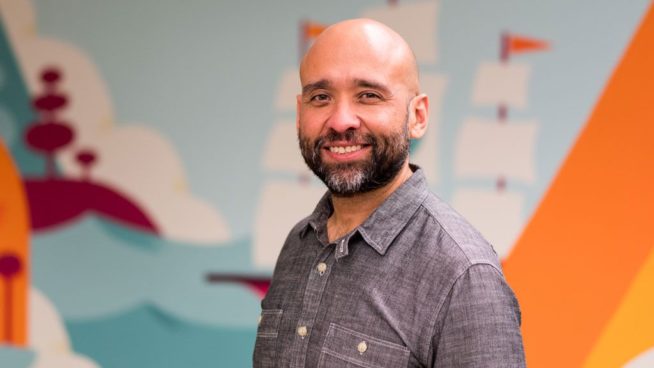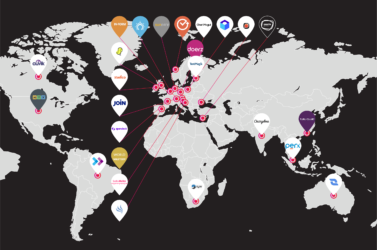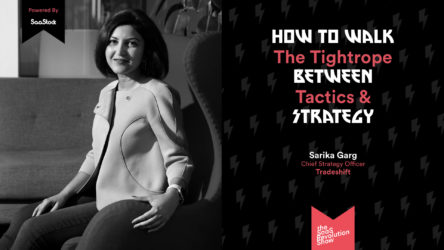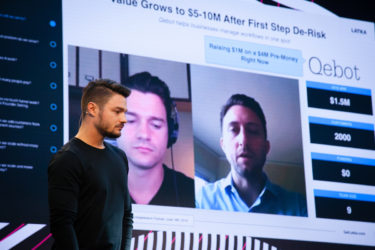You would be forgiven for thinking David Cancel’s timing was a bit peculiar. Only a few days before his employer at the time, HubSpot, went public on October 10th, 2014, David left the company. He had been HubSpot’s Chief Product Officer for the good part of 3 years after his company Performable had been acquired by the marketing automation maker.
Why was he in such a rush?
There were too many burning stones under his feet. For one he had the very nagging feeling that he no longer was learning anything on the job. That alone was a killer.
But there was also something else – a megatrend David was witnessing around him that was too fascinating not to explore. It wasn’t a new technology or a funky platform. However, it was more ubiquitous than ever before.
Messaging.
Could David use the proliferation of messaging to solve a problem it wasn’t yet addressing? It was an unusual way for him to kickstart a company. In his 20-year tenure as an entrepreneur, David had usually fixated on an idea or a technology. This time he was doing it differently.
A year of experimentation with messaging followed. Four unsuccessful experiments later, David and his co-founder Elias Torres found the idea. Drift was born.
By April 2016, they launched the product – a messaging tool that brought back the conversation between marketers and salespeople and their customers, solving one of business’s biggest miscommunication conundrums.
“It’s obvious in hindsight, but it took us a while to figure out that people would soon expect to be able to chat to companies the way they do with their friends – informal, friendly and on their terms.”
Less than two years later, Drift is fast becoming a model how to grow a SaaS company extraordinarily. There are the numbers to support such a bold statement – close to 60,000 customers, $47 million in funding, nearly 100 employees. They are fascinating in their own right and scream anything but patience; however, put them in the context of a vertical overcrowded with competition and the feat begins to shine its true light.
Do things that do not scale
There lays a tactic aligned with hypergrowth that is almost an oxymoron to it – 1:1 personal conversations. One at a time, these 1:1s have not just helped Drift grow but have accumulated to a movement about conversational marketing.
Drift, beyond an experiment with messaging, is an experiment with Paul Graham’s seminal advice – do things that do not scale.
To that statement, David has also added unconventional. “It was the only way we stood a chance in the overcrowded marketing tech space.” A space David knew too well, having grown some of the companies in it.
Read on to learn what are the unscalable and unconventional steps that David took to build a movement of believers in the power of conversation.
Simple things, not easy
In SaaS, there is an irresistible lure for doing things that are easy to measure. It’s inevitable when growth is a prerogative of the industry. What that inevitably means is that most players end up going for the proven tactics that can be measured. “Everyone does the same things.” The pursuit then is not what to do but how to do it more efficiently and smarter.
None of that appealed to David. He was under no illusion that he could outspend, out-efficient or outperform 5000 other SaaS marketing companies that were all targeting marketers and salespeople.
That meant that he and Elias were not only confronted with figuring out what specific problem to solve and what product to build, but also how to excite people.
It meant they needed a bigger idea that stood behind the product.
They thought long and hard what to do. It had to be different than anything anyone else was doing. That didn’t mean reinventing the wheel with complex tactics. “We needed an arbitrage opportunity that is difficult to measure.” A simple thing that is not easy to execute.
A movement for conversation marketing, build one conversation at a time.
Conversations to understand salespeople and marketers and their pains and difficulties. Conversations to simply explain the ideas David and Elias were meddling with. It had to happen in an unscalable 1:1 way. Conversations that had to have no ego, and much vulnerability.
In a world where everyone tries to automate marketing and exude confidence, David turned everything on its head.
At the early days, there wasn’t a name for the movement. That would come later with #NoForms. However, the preparation for it started from day one.
These are the few rules he followed:
Don’t go to the obvious people first
To reach as broad a group of people, David neglected the recommendation to start with his network and instead went to as far removed ones as possible – strangers in coffee shops.
People we knew would have only humored us.
It was also the surest way to get the all-important in-person connection.
It was a vulnerable way to do it for David. He may not strike as one, but he is a bit of an introvert.
“There are many salespeople who work from coffee shops, and it’s not difficult to recognise them.” Few other SaaS founders would dare to talk to strangers like that.
David would grab a coffee, sit down and observe. He would single out the people who were on calls rather than just writing on their laptops. Those were the ones who were potentially in sales. He would approach someone in the following way:
David: Hey l noticed you were on a few calls, are you in sales by any chance? Do you have 2 minutes so I can ask you something?
Stranger: Sure, what do you sell?
David: I am building software to help salespeople do x, y, and z. Can I tell you about it and ask you a couple of things about it?
Stranger: Sure.
David: What kind of sales do you do, which company?
Stranger: X
David: Oh cool I know someone there… or, Interesting, do you mind sharing a little about how you guys do sales/marketing…
All these would help David establish a common language with the person and disarm them, breaking the wall between them. With empathy in place, David could then ask the questions he cared about most.
Ask the right questions
The point of the questions was to help them see through the problem themselves – the way sales and marketing is currently done is not human. David would use their own habits to showcase that. He would always ask the same three questions:
- Do you answer phone calls from people you do not know?
- When you go to websites, do you fill out those forms they give you?
- Do you ever reply to one of the hundred emails you get from salespeople asking for 15 minutes of your time, offering a silly gif in return?
Usually, they would laugh at his face and say no to each.
Then he would add a fourth, unexpected question:
Do you use any of them when you do marketing?
More often than not it would turn out that the marketers and salespeople who didn’t like the tactics he described, used exactly those in their companies.
David would now have the person’s full attention and openness to the idea of a different kind of approach.
He asked them about their experience of using messaging and the bad experience they had had so he could learn what not to do. With each new person he talked to, he would restate the problems and see if the person would agree.
Everyone in Drift took turns do these 1:1 conversations.
Once the answers to the questions began sounding similar from the salespeople they met in coffee shops, they looked for another cohort. They attended many events and meetups where they med the demand generation experts, the Heads of Sales and the marketers.
It was only after they kept seeing the same faces that they turned to their network.
Ask for money immediately. Grandfather forever.
The more people they spoke with, the more they got the nod of approval. People liked the ideas.
That, however, didn’t mean that the pain was strong enough to pay for an unproven painkiller. Instead of asking whether they would pay for Drift, David asked directly for money. “Give me the money you have in your pocket,” he would say.
To make it more compelling, he would offer lifetime access to Drift in return.
Some people gave him a $5 bill, others a $100 bill. “I still keep all of them to remind me of those days.” Whatever the sum they gave him, they would be grandfathered on it for life.
Was David selling Drift too cheaply?
Don’t get lost in minutia – if your market is big enough it really won’t matter that you have given access to a few people for a ridiculously small amount of money.
Besides, the experience would immediately turn them into advocates.
David began seeing others talking about the ideas that he and Drift were talking about. Sometimes they would quote them; sometimes they wouldn’t. “That’s when we knew we had really kickstarted a movement.”
Was it worth it for the bottom line? (Just asking for an ROI-obsessed friend)
“Many people didn’t believe the problem was big enough to give us money or to give Drift a try at the time. But somehow from that personal interaction, they have all come back to Drift in one way or another.”
1:1 conversations continue to this day. They remain the thing that has fuelled the movement David and Drift are aiming to build about conversation marketing.
However, to reach critical mass, the movement also needed more mass outreach ways to reach a bigger audience. David divided that into air and ground cover. Air cover is the 1-to-many approach such as content Drift created. The ground cover were personal 1:1 conversations at scale at Drift organised events.
Air cover
Write as you speak
A child of a Puerto Rican father and an Ecuadorian mother, David had grown up speaking Spanish in the Bronx. As a non-native English speaker, he had developed an obsession with the language and how to sound correct and always be understood. He had spent years reading the likes of Seth Godin to perfect the art of expressing ideas in simple ways. That had always reflected on his own writing for his blog, and the same had to be true for Drift.
How could he transfer that to the rest of Drift’s marketing team?
When he hired Dave Gerhardt as Head of Marketing in October 2015, the first thing he gave him to read were books from the 1940s and 50s around copywriting and advertising. Books like Ogilvy on Advertising, The Robert Collier Letter Book, Scientific Advertising, Cashvertising.
These books were all written at a time when a company had very limited space to advertise – usually on the back pages of a magazine. However, they had a big challenge – convince a person to post them a check with the hopes of getting a product in six months or so. “Being able to write convincingly and concisely to sell that is the ultimate skill.”
Drift’s writing had to be human and personal with no jargon. The rules were simple – “If you wouldn’t say it, don’t write it.” That, for example, meant no annoying CTAs. The one that has worked really well for Drift is “P.S. Can we send you an email?”
Emails, in turn, were designed to get a response. In Drift’s Welcome email people are asked why they signed up.
Other questions you could ask are:
- What are you looking to accomplish?
- What are you struggling with?
- What brought you to use our product or service?
The same questions David would ask in person.
Record your conversations
As of writing this, there are 106 episodes of Seeking Wisdom, Drift’s podcast where David Cancel and David Gerhardt have a chat between themselves or with a guest.
While an informal chat makes the perfect sense for them, it wasn’t an obvious one two years ago. Rather it was a chance idea that just popped up.
In early 2016, shortly after Dave had been hired, he and David were having a conversation as they always did in the office. “You should record this and do a podcast,” someone told them.
In its first year, it got 100,000 downloads and 175 reviews. That, in part, was because David opted once more for unconventionality.
“This was another instant we couldn’t win on doing what everyone else was doing. We wouldn’t be able to make the slickest podcast, so we decided to go the other way.” They decided to just be themselves.
Everyone wants to avoid being vulnerable. We didn’t.
What mattered was that they felt good about what they talked about. “We addressed the questions we would get all the time from people, which spanned much more than just work but rather how to stay healthy or curious and always learn.” It was a return to the same principal of more intimate relationships.
It turns out people wanted raw, uncut, honest, and informal conversations about business, life, and learning. “When we threw out the scripts and just started talking about what was on our minds in an authentic way, things started to take off, and we started to build an audience.”
How did they know it was working? People they met would tell them so.
Ground cover
Scaling the conversation had to be done in person too. “The ground cover would always work better than the air cover.” This is where events came in.
The natural thing from the beginning were dinners, which David hosted around the country once a month. Not too big so he could have a conversation with each guest, but still on a bigger scale than one. They decided to keep them to up to ten people.
The guest list was a mix of serendipity and plan. A few were local customers, but the rest were people that would share similar interests so an organic conversation could spur more naturally. “We always made sure they have similar job roles or share similar interests.” To find them, they would do research and ask for recommendations.
The next natural step was a conference. Drift named it HYPERGROWTH and decided on a few ground rules like no sponsorship or vendor booths. Lucky winners got lifetime tickets for future iterations of the conference. All attendees got a personal email to be invited to give Drift’s new product a try.
The latest addition to the cohort of events is the Drift Roadshow, with no lanyards or much of an agenda and varying in size anywhere between 20 and 300 people, all it really aims is to spark a conversation.
Final thoughts
You can be forgiven once more – this time for wondering how all this applies to you and your company. David Cancel, after all, is a four-time founder and had $15 million in the back pocket to experiment with the unscalable. He could afford failure. Most founders do not have the time and luxury to build a movement.
The truth, however, is that, as David will tell you, the unscalable is not a luxury. It’s rather your only shot at standing out and prevailing in today’s reality. The old ways will not stand. You will need something more than a great product and a proven marketing playbook. To start your own movement do the following:
- Have as many 1:1 personal conversations with people as far removed from you as possible
- Lay its foundations willing to let go of ego and show vulnerability
- Don’t waste time thinking how to “out-slick” the competition, rather ponder how to be genuine and unconventional
Want more practical advice from David Cancel? He will probably repeat what his grandmother taught him (it only took him 30 years to understand it):
Be nice to people, do the work, show up on time, and leave things in better shape than when you found them.




